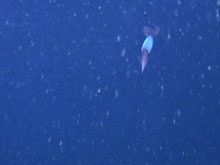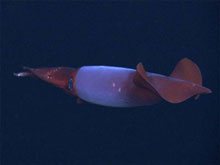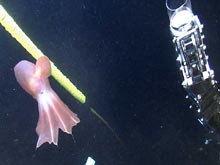
A BoreoAtlantic Armhook Squid, Gonatus fabricii. Click image for larger view.
A close-up of BoreoAtlantic Armhook Squid, Gonatus fabricii. Click image for larger view.
Cephalopods in the Canada Basin, Arctic Ocean
July 6, 2005
Michael Vecchione
NMFS National Systematics Lab.
Smithsonian Institution
![]() View
a video of a BoreoAtlantic Armhook Squid, Gonatus fabricii.
(mp4, 451 KB)
View
a video of a BoreoAtlantic Armhook Squid, Gonatus fabricii.
(mp4, 451 KB)
I am sitting here at the National Museum of Natural History in Washington, DC, turning green with envy. I just received a series of e-mails from the 2005 Ocean Exploration expedition supporting the Census of Marine Life in the Arctic Ocean. Attached to the e-mails are several images taken from videos recorded a few days earlier in the deep waters of the Canada Basin. My envious green tint is because the videos have finally captured footage of cephalopods (squids and octopods) in this region. I wish I was out on the ship.
The images include a "BoreoAtlantic Armhook Squid", scientific name - Gonatus fabricii, and a finned octopod named Cirroteuthis muelleri (a third cephalopod was seen but not recorded). These are among the species I had hoped to find while participating in the 2002 OE Arctic cruise. Unfortunately we saw no cephalopods in 2002. Prior to the current science cruise, mission coordinator Jeremy Potter promised me they would find a cephalopod; I was somewhat skeptical. That emotion was immediately transformed by an e-mail telling me that the first two ROV dives had found cephalopods.
Finned octopods, known technically as cirrates, are sometimes called "Dumbos" because the large fins make them look like flying cartoon elephants flapping their ears. They are among the largest organisms of the deep sea. The species seen in the Canada Basin can grow to 1.5 m in length. Because they are difficult to collect, their biology and ecology are poorly known.
Cirroteuthis muelleri is known to be fairly common in the Arctic around Greenland and is found in both the North Atlantic and North Pacific Oceans. The species was photographed in the 1960s at depths of 3000-4000 m in the western Canada Basin, so I was surprised and disappointed that we did not see it in any deep ROV dives in 2002. I am now reassured that dumbo still flies in the Canada Basin. Images of live animals in their environment are of particular interest because they show delicate details, like the tips of the arms, which are not obvious in preserved specimens, as well as behavior.
The squid species is common in the sub-arctic waters of the Atlantic, where it can be sufficiently abundant to support commercial fisheries. In places where it is abundant this squid is a major predator, also serving as prey for many fishes and marine mammals. The squid may be an important component of the open-water food web of the high Arctic, but we know very little about its occurrence there.
An important aspect of the new age of exploration is the ability to communicate rapidly and effectively. Through the magic of e-mail with digital images bouncing off satellites, the onboard team is quickly able to show me cephalopods being found. I identify the animals, check what is known about them, and ask that special procedures be used if a specimen is collected. That way, in addition to an archived museum specimen to document the discovery, I would be able to work with one of my graduate students to perform DNA analyses for contribution to the barcode of life project and her dissertation research. Despite thousands of miles separating scientists studying life in the Canada Basin and myself, I am still able to take part in the scientific research and identify creatures discovered in the deep sea.
Sign up for the Ocean Explorer E-mail Update List.


































